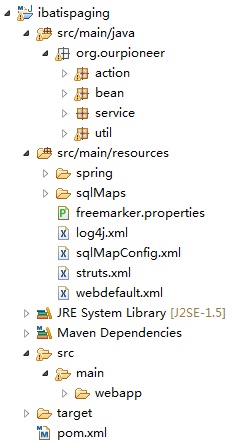这篇文章给大家介绍基于Struts2和Freemarkeri的Batis分页是怎么样的,内容非常详细,感兴趣的小伙伴们可以参考借鉴,希望对大家能有所帮助。
之前介绍过基于Hibernate分页的原理和设计,这里我们所用的分页都是物理分页技术,不是JS实现的页面分页技术,是在SQL语句上执行的分页,可以获取结果集数量固定的列表,执行效率很高。下面来看看iBatis中如何设计分页,本文基于Struts2,Spring3来整合,因为暂时Spring不支持MyBatis3(可以选用MyBatis官方的MyBatis-Spring插件来实现,配有中文文档,很好理解),我们这里仍然以iBatis2作为载体来介绍。
首先就是搭建开发环境,这里可以说也是对Struts2,Spring3和iBatis2进行了简单的整合,大家也可以来参考。项目的结构如下,使用Maven创建的web项目:

添加必要的依赖,因为整合了Struts2和Spring,依赖就比较多了,如下:

首先来配置一下Struts2,这个就比较简单了,相信大家都不陌生。在web.xml中:
Xml代码
<filter> <filter-name>struts2filter-name> <filter-class>org.apache.struts2.dispatcher.ng.filter.StrutsPrepareAndExecuteFilterfilter-class> filter> <filter-mapping> <filter-name>struts2filter-name> <url-pattern>*.actionurl-pattern> filter-mapping>
然后是struts.xml,配置Struts相关的内容,这里我们配置freemarker为默认的结果类型,然后配置一个测试的Action,因为和Spring进行了集成,所以Action具体的配置放到Spring中来进行,如下即可:
Xml代码
<?xml version="1.0" encoding="UTF-8" ?> "-//Apache Software Foundation//DTD Struts Configuration 2.1.7//EN" "http://struts.apache.org/dtds/struts-2.1.7.dtd"> <struts> <package name="ibatis-paging" extends="struts-default" namespace="/"> <result-types> <result-type name="freemarker" class="org.apache.struts2.views.freemarker.FreemarkerResult" default="true" /> result-types> <action name="user_*" class="userAction" method="{1}"> <result name="list">user_list.ftlresult> action> package> struts>对Freemarker做一个简单的设置,卸载freeemarer.properties文件中即可,这里我们主要是引用了一个宏文件,就是分页宏的配置,如下:
Properties代码
template_update_delay=5 default_encoding=UTF-8 url_escaping_charset=UTF-8 number_format=0.# date_format=yyyy-MM-dd time_format=HH:mm:ss datetime_format=yyyy-MM-dd HH:mm:ss boolean_format=true,false whitespace_stripping=true tag_syntax=auto_detect auto_import=/Freemarker/page_macro.ftl as p
Log4J的配置这里不再贴出代码,大家可以去下载源码,一看就明白了,之后我们配置Spring,在resources文件夹下创建spring子目录,里面放置Spring的配置文件,在web.xml中如下设置即可加载Spring的配置文件:
Xml代码
<context-param> <param-name>contextConfigLocationparam-name> <param-value>classpath:spring public class PagingList { private int rowCount = 0; // 记录总数 private int pageCount = 1; // 分页总数 private int pageSize = 10; // 每页记录数 private int pageNum = 1; // 当前页数 private int startIndex = 1; // 起始记录数 private int endIndex = 1; // 结束记录数 private List list;// 记录列表 public PagingList(String statementName, Object parameterObject, int pageNum, int pageSize, SqlMapClientTemplate sqlMapClientTemplate) { preProcessParams(pageNum, pageSize); execute(statementName, parameterObject, pageNum, pageSize, sqlMapClientTemplate); } public PagingList(String statementName, int pageNum, int pageSize, SqlMapClientTemplate sqlMapClientTemplate) { preProcessParams(pageNum, pageSize); execute(statementName, pageNum, pageSize, sqlMapClientTemplate); } blic void execute(String statementName, Object parameterObject, int pageNum, int pageSize, SqlMapClientTemplate sqlMapClientTemplate) { // 计算记录总数 this.rowCount = sqlMapClientTemplate.queryForList(statementName, parameterObject).size(); // 计算分页数及起止记录 countPage(); // 获取分页列表 this.list = sqlMapClientTemplate.queryForList(statementName, parameterObject, (pageNum - 1) * pageSize, pageSize); } public void execute(String statementName, int pageNum, int pageSize, SqlMapClientTemplate sqlMapClientTemplate) { // 计算记录总数 this.rowCount = sqlMapClientTemplate.queryForList(statementName).size(); // 计算分页数及起止记录 countPage(); // 获取分页列表 this.list = sqlMapClientTemplate.queryForList(statementName, (pageNum - 1) * pageSize, pageSize); } private void preProcessParams(int pageNum, int pageSize) { if (pageNum > 0) { this.pageNum = pageNum; } if (pageSize > 0) { this.pageSize = pageSize; } if (pageSize > 1000) { this.pageSize = 1000; } } private void countPage() { // 计算分页总数 if ((rowCount % pageSize) == 0) { pageCount = rowCount / pageSize; } else { pageCount = rowCount / pageSize + 1; } if (pageCount == 0) { pageCount = 1; } // 判断pageNum是否过界 if (pageNum > pageCount && rowCount != 0) { pageNum = pageCount; } // 计算起止记录 startIndex = (pageNum - 1) * pageSize + 1; endIndex = (pageNum) * pageSize; } public List getList() { return list; } public int getStartIndex() { return startIndex; } public Integer getStartIndexInteger() { return new Integer(startIndex); } public int getEndIndex() { return endIndex; } public Integer getEndIndexInteger() { return new Integer(endIndex); } public int getPageCount() { return pageCount; } public int getPageNum() { return pageNum; } public int getPageSize() { return pageSize; } public int getRowCount() { return rowCount; } }写好分页类,还要和框架进行集成,那么我们可以抽象出Service的基类,在业务逻辑层中调用它来获取分页信息:
Java代码
package org.ourpioneer.service; import org.ourpioneer.bean.PagingList; import org.springframework.orm.ibatis.SqlMapClientTemplate; import com.opensymphony.xwork2.ActionContext; import com.opensymphony.xwork2.util.ValueStack; public class BaseService { public ValueStack getValueStack() { return ActionContext.getContext().getValueStack(); } public PagingList getPagingList(String statementName, SqlMapClientTemplate sqlMapClientTemplate) { int pageNum = ((Integer) getValueStack().findValue("pageNum")) .intValue(); int pageSize = ((Integer) getValueStack().findValue("pageSize")) .intValue(); return new PagingList(statementName, pageNum, pageSize, sqlMapClientTemplate); } public PagingList getPagingList(String statementName, Object parameterObject, SqlMapClientTemplate sqlMapClientTemplate) { int pageNum = ((Integer) getValueStack().findValue("pageNum")) .intValue(); int pageSize = ((Integer) getValueStack().findValue("pageSize")) .intValue(); return new PagingList(statementName, parameterObject, pageNum, pageSize, sqlMapClientTemplate); } }两个构造方法我们都使用了,也就是一个带参数,一个不带参数。下面来看抽象出的Action基类,主要是处理页面传入的分页参数的处理:
Java代码
package org.ourpioneer.action; import java.util.Map; import javax.servlet.http.HttpServletRequest; import org.apache.struts2.ServletActionContext; import org.ourpioneer.util.QueryUtil; import com.opensymphony.xwork2.ActionContext; import com.opensymphony.xwork2.ActionSupport; public class BaseAction extends ActionSupport { @Override public String execute() throws Exception { return SUCCESS; } public Map getParameters() { return ActionContext.getContext().getParameters(); } public HttpServletRequest getRequest() { return ServletActionContext.getRequest(); } protected int pageNum = 1; protected int pageSize = 10; public int getPageNum() { return pageNum; } public void setPageNum(int pageNum) { this.pageNum = pageNum; } public int getPageSize() { return pageSize; } public void setPageSize(int pageSize) { this.pageSize = pageSize; } public int getMaxPageSize() { return 1000; } public int getDefaultPageSize() { return 10; } // 页面解析分页信息使用的方法 public String getQueryStringWithoutPageNum() { Map m = getParameters(); m.remove("pageNum"); return QueryUtil.getQueryString(m); } public String getFullUrlWithoutPageNum() { return getRequest().getServletPath() + "?" + getQueryStringWithoutPageNum(); } public String getQueryStringWithoutPageInfo() { Map m = getParameters(); m.remove("pageNum"); m.remove("pageSize"); return QueryUtil.getQueryString(m); } public String getFullUrlWithoutPageInfo() { return getRequest().getServletPath() + "?" + getQueryStringWithoutPageInfo(); } }这里为了演示,我们将分页的信息都直接定义死了,大家可以根据需要来修改,其中处理信息的QueryUtil大家可以直接参考源代码,这里不做说明了,下面是UserAction处理代码的编写:
Java代码
package org.ourpioneer.action; import org.ourpioneer.bean.PagingList; import org.ourpioneer.service.UserService; public class UserAction extends BaseAction { private UserService userService; public PagingList userList; public void setUserService(UserService userService) { this.userService = userService; } public PagingList getUserList() { return userList; } public String list() { userList = userService.getAllUsers(); return "list"; } }根据前面的配置,我们也不难写出代码,下面就是视图处理了,我们使用了Freemarker进行解析,也编写了FreeMarker的分页宏:
Html代码
<#-- 处理分页参数 --> <#function getPageUrl pageNum> <#local pageUrl=base+fullUrlWithoutPageInfo> <#if pageUrl?ends_with("?")> <#return pageUrl + "pageSize=" + pageSize + "&pageNum=" + pageNum> <#else> <#return pageUrl + "&pageSize=" + pageSize + "&pageNum=" + pageNum> #if> #function> <#-- 全部或分页显示 --> <#function getPageUrlResize size> <#local pageUrl=base+fullUrlWithoutPageInfo> <#if pageUrl?ends_with("?")> <#return pageUrl + "pageNum=1&pageSize=" + size> <#else> <#return pageUrl + "&pageNum=1&pageSize=" + size> #if> #function> <#-- 分页信息 --> <#macro paging pagingList> <#local pageCount=pagingList.pageCount> <#local rowCount=pagingList.rowCount> <#local pageNum=pagingList.pageNum> <#local pageSize=pagingList.pageSize> <#if rowCount == 0> <#if useFlag?exists> <div style="border:1px solid #666;padding:2 5 2 5;background:#efefef;color:#333">没有相关记录div> <#else> <#assign useFlag = 1> #if> <#else> <table> <tr> <td style="line-height:150%">共 ${rowCount} 条记录 ${pageCount} 页 <#if pageCount gt 1 && pageSize!=maxPageSize> <span class="selectedPage" style="padding:2px 3px 0 3px"><a class="page" href="${getPageUrlResize(maxPageSize)}">全部显示a>span> <#elseif pageSize==maxPageSize> <span class="selectedPage" style="padding:2px 3px 0 3px"><a class="page" href="${getPageUrlResize(defaultPageSize)}">分页显示a>span> #if> <#if (pageCount <= 11)> <#local startPage = 1> <#local endPage = pageCount> <#elseif (pageNum + 5 > pageCount)> <#local startPage = pageCount - 10> <#local endPage = pageCount> <#elseif (pageNum - 5 < 1)> <#local startPage = 1> <#local endPage = 11> <#else> <#local startPage = pageNum - 5> <#local endPage = pageNum + 5> #if> <#if (pageCount > 1)> <#if (pageNum != 1)> <#if (pageCount > 11)> <a class="page" href="${getPageUrl(1)}" style="font-family:Webdings" title="首页">9a> #if> <a class="page" href="${getPageUrl(pageNum-1)}" style="font-family:Webdings" title="上页">3a> <#else> <#if (pageCount > 11)> <span style="font-family:Webdings;color:#999">9span> #if> <span style="font-family:Webdings;color:#999">3span> #if> <#list startPage..endPage as x> <#if x=pageNum> <span class="selectedPage">${x}span> <#else> <span class="noSelectedPage"><a class="page" href="${getPageUrl(x)}">${x}a>span> #if> #list> <#if (pageCount != pageNum)> <a class="page" href="${getPageUrl(pageNum+1)}" style="font-family:Webdings" title="下页">4a> <#if (pageCount > 11)> <a class="page" href="${getPageUrl(pageCount)}" style="font-family:Webdings" title="尾页">:a> #if> <#else> <span style="font-family:Webdings;color:#999">4span> <#if (pageCount > 11)> <span style="font-family:Webdings;color:#999">:span> #if> #if> #if> td> tr> table> #if> #macro>之后,我们来运行项目:

可以通过点击全部显示和页面来查看分页效果。
关于基于Struts2和Freemarkeri的Batis分页是怎么样的就分享到这里了,希望以上内容可以对大家有一定的帮助,可以学到更多知识。如果觉得文章不错,可以把它分享出去让更多的人看到。




